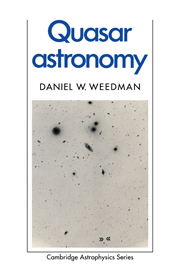2 - Quasar surveys
Published online by Cambridge University Press: 18 December 2009
Summary
Optical surveys for quasars
Quasars cannot be studied until they are found. The purpose of any quasar survey is simply to provide an efficient method of discovering quasars. This efficiency is greatly enhanced if many quasars can be found with a single observation by the detecting instrument, so it is preferable if the observation has a wide enough field of view to include many detectable quasars. Furthermore, it is desirable but usually not feasible to identify a quasar with the survey observation alone, without the necessity of a subsequent observation with another instrument. Because of their characteristic signatures in many different parts of the spectrum, quasars can be surveyed for using various techniques. Much of the subsequent research effort goes into comparison of results from various techniques, to determine whether the same quasars are being found in different ways, or whether there are categories of quasars conspicuous to one form of observation but invisible to another.
Color based surveys
Quasars are easy to find with optical telescopes; a summary compilation by Smith (1984) lists over 40 surveys. The reason is because their spectral characteristics are so different from most stars and galaxies that broad band optical surveys using only three effective wavelengths can differentiate most quasars from other objects. Despite many other techniques for quasar surveys, including X-ray and radio surveys, the great majority of quasars have been discovered optically, and it is very probable that this will continue to be so.
- Type
- Chapter
- Information
- Quasar Astronomy , pp. 19 - 44Publisher: Cambridge University PressPrint publication year: 1986



